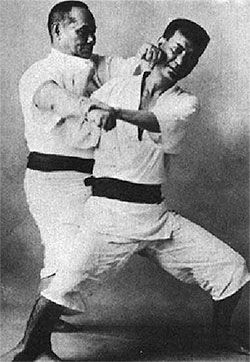Jesse Enkamp, the so-called “Karate Nerd” over in Sweden, has posted a video about “the three kinds of karate.” Enkamp gives a concise and accurate description of the evolution of karate’s purposes from its Okinawan roots to its first appearance as an Olympic sport next summer in Tokyo.
The three types, corresponding roughly to late-18th and 19th centuries, early-mid 20th century, and late 20th century onward, are as follows: Okinawan (for actual civilian self-defense), Japanese (for a holistic blend of mental, spiritual, and physical self-improvement), and Sport (for competition with defined rules, weight classes, etc.).
At Shuto Karate Club, DelGuidice Sensei and myself both came up through the ranks to Black Belt by learning karate the Japanese way, which is “traditional” in the sense that it is colored by Japanese etiquette and budo philosophy. (See Inazo Nitobe’s Bushido: The Soul of Japan.) This also generally includes competitive sparring and entering the occasional tournament. I’m not sure what kind of Shotokan teaching Shuto Karate Club’s founder, Louis Rabouin, received, but I do know that he founded the American Self-Defense Karate Association (ASDKA) at about the same time he started Shuto Karate Club (1960).
I also practiced both Wado Ryu and Shotokan karate during my three years living in Japan, and all karate I experienced was Japanese (of course) with a little Sport thrown in.
In my opinion, Shuto Karate Club Sellersville represents an additional type not mentioned by Enkamp. We combine the traditional Japanese emphasis on etiquette and certain rituals, a budo ethic, and the practice of kihon and kata, with an emphasis on “Combatives,” that is, applying our techniques and maneuvers in ways that would actually be useful in self-defense situations. In this way, we are looping back and attempting to revive the “original intent” of the Okinawan masters.
The British are considered to be at the pioneers of this modern approach to karate as a tool for self-protection — it really started to take hold during the 1990s. Some of the people who have been influencing my approach to teaching are Iain Abernethy, Jamie Clubb, and the American Rory Miller.
Here is a fine discussion thread from Iain Abernethy on combining Japanese karate training methods with modern combative approaches: Karate and Combatives.
I should not conclude this post without a bow to my own master teacher, Robert Trotta, who allowed me to experience a “renaissance” in my karate training when I joined Shuto Karate Club 10 years ago. His extensive knowledge of self-defense, his instruction, and also the freedom he gave me to explore, are impossible to place a value on.


